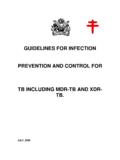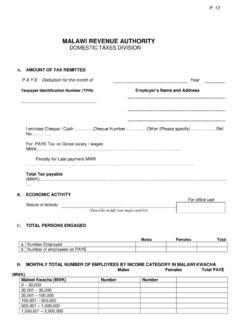Transcription of Livelihood Diversification and Vulnerability to …
1 Livelihood Diversification and Vulnerability to poverty in rural malawi ESA Working Paper No. 15-02 August 2015 Agricultural Development Economics Division Food and Agriculture Organization of the United Nations Livelihood Diversification and Vulnerability to poverty in rural malawi Solomon Asfaw, Nancy McCarthy, Adriana Paolantonio, Romina Cavatassi, Mulubrhan Amare and Leslie Lipper Food and Agriculture Organization of the United Nations Rome, 2015 Recommended citation FAO. 2015. Livelihood Diversification and Vulnerability to poverty in rural malawi , by Solomon Asfaw, Nancy McCarthy, Adriana Paolantonio, Romina Cavatassi, Mulubrhan Amare and Leslie Lipper. ESA Working Paper No. 15-02. Rome. The designations employed and the presentation of material in this information product do not imply the expression of any opinion whatsoever on the part of the Food and Agriculture Organization of the United Nations (FAO) concerning the legal or development status of any country, territory, city or area or of its authorities, or concerning the delimitation of its frontiers or boundaries.
2 The mention of specific companies or products of manufacturers, whether or not these have been patented, does not imply that these have been endorsed or recommended by FAO in preference to others of a similar nature that are not mentioned. The views expressed in this information product are those of the authors and do not necessarily reflect the views or policies of FAO. FAO, 2015 FAO encourages the use, reproduction and dissemination of material in this information product. Except where otherwise indicated, material may be copied, downloaded and printed for private study, research and teaching purposes, or for use in non-commercial products or services, provided that appropriate acknowledgement of FAO as the source and copyright holder is given and that FAO s endorsement of users views, products or services is not implied in any way. All requests for translation and adaptation rights, and for resale and other commercial use rights should be made via or addressed to FAO information products are available on the FAO website ( ) and can be purchased through Livelihood Diversification and Vulnerability to Poverty in Rural Malawi1 Solomon Asfaw1*, Nancy McCarthy2, Adriana Paolantonio1, Romina Cavatassi1, Mulubrhan Amare3 and Leslie Lipper1 1* Corresponding author: Food and Agriculture Organization of the United Nations (FAO), Agricultural Development Economics Division, Viale delle Terme di Caracalla, 00153 Rome, Italy E-mail: 2 LEAD Analytics, Inc.
3 , Washington DC, USA 3 Leibniz University of Hannover, Faculty of Economics and Business Administration, Hannover, Germany Abstract Climate variability, associated with farm-income variability, is recognized as one of the main drivers of Livelihood Diversification strategies in developing countries. Analysing determinants of Livelihood Diversification choices, to better understand household strategic behaviour in the event of climatic risks and other shocks, is important for the formulation of development policies in developing countries highly dependent on rain-fed agriculture, like malawi . We use geo-referenced farm-household-level data collected in 2010-11 to investigate how climatic variability influences the pattern of Diversification that farmers adopt, and the impacts of these choices on welfare.
4 To do so we apply the Vulnerability to expected poverty approach which measures the future level of poverty taking into consideration the role of risk and uncertainty. The analysis considers the effect of policies and institutions such as fertilizer subsidies, extension services, safety-net and credit on Diversification choices. The results show that higher levels of climate risk generally increase the likelihood of Diversification across labour, cropland and income, suggesting the importance of Diversification as a response to constraints imposed by increased risk. In contrast, we find that in areas with favourable average rainfall conditions households are more likely to diversify income, suggesting Diversification as a response to opportunities. In terms of welfare, the analysis performed on the components of Vulnerability to poverty provides evidence that climatic variables are key determinants of both components of Vulnerability (expected consumption and its variance).
5 Fertilizer subsidies are found to be significant in Diversification choices for all dimensions and also particularly effective in reducing Vulnerability to poverty in high variability environments although the same does not hold for extension. Looking at differences across gender, we find that women labour Diversification is less responsive than men s, resulting in a lower positive impact on expected consumption per capita. Key words: Climate change, Diversification , impact, malawi JEL Classification: Q01, Q12, Q16, Q18 1 This research forms part of the Economic and Policy Innovation for Climate-Smart Agriculture (EPIC) Project ( ), supported financially by the European Union (EU) and the Swedish International Development Agency (SIDA). We would also like to acknowledge the World Bank for sharing the malawi Third Integrated Household Survey (IHS3) dataset with us and particularly Mr Talip Kilic and Ms Siobhan Murray for their valuable support during the construction of the dataset.
6 We are grateful to Giulio Marchi, Geospatial Analyst at FAO, for his valuable support for the extraction of the climate data. The authors would also like to thank Ms Robyn Hean for editorial support and Mr Panagiotis Karfakis for technical input. We also thank the staff at the Headquarters and the malawi office of FAO for their comments and suggestions during the preparation of this paper. Errors are the responsibility only of the authors, and this paper reflects the opinions of the authors, and not the institutions which they represent or with which they are affiliated. iv Table of contents Abstract .. iii 1. Introduction .. 1 2. Diversification and climate variability in developing countries .. 2 3. Climate change and Livelihood Diversification in malawi .. 4 4. Data and variable construction .. 6 Data .. 6 Diversification indices .. 9 5. Conceptual framework and analytical methods.
7 11 6. Econometric results .. 13 Determinants of Diversification .. 13 Effects of climate risk on household welfare .. 15 Relation between Diversification and household welfare .. 17 7. Conclusions and policy implications .. 20 References .. 22 Appendix .. 27 1 1. Introduction The latest figures from FAO report that over 214 million people in Sub-Saharan Africa (SSA) suffer from chronic hunger (FAO, IFAD and WFP, 2014). The share of people living on less than $ a day in this region started to decrease only from 2008, though it still remains the highest in the world ( in 2010) (World Bank, 2010). In recent years, the goals of poverty alleviation and of achieving food security in SSA have been in the forefront of national and international policy agendas. The pathway to food security in many of these countries depends heavily on the growth and development of the agricultural sector, which is the dominant sector in their economies (World Bank, 2008).
8 Agriculture, by its very nature, is highly dependent on weather patterns, and given the very high number of people dependent on rain-fed agriculture in SSA, the implications of weather variability for poverty and Vulnerability are easy to imagine. Recent evidence suggests that global climate change is likely to increase the incidence of natural hazards, as well as the variability of rainfall, temperature and other climatic parameters (IPCC, 2012). As a result, it is expected that all aspects of food security may be potentially affected by climate change, including food availability, access, utilization, and stability ( , Challinor et al., 2010; IPCC, 2014). malawi is ranked as one of the world s twelve most vulnerable countries to the adverse effects of climate change (World Bank, 2010), and subsistence farmers are expected to suffer from climate-related stressors in a number of ways.
9 These include increased exposure to extreme climate events, such as droughts, dry spells and floods, in addition to erratic and unreliable rainfall (Chinsinga, 2012). Given that agricultural production remains the main source of income for most rural communities, the increased risk of crop failure, associated with increased frequency of extreme climate events, poses a major threat to food security and poverty reduction. Adaptation of the agricultural sector to the adverse effects of climate change is thus an important priority, to protect and improve the livelihoods of the poor and to ensure food security (Bradshaw, Dolan and Smit, 2004; Wang et al., 2009; Asfaw et al., 2014). Households exposed to the risks of weather and other shocks thus have significant incentives to devise strategies to adapt or cope with the effects of climate variability ( , Morton, 2007; Howden et al.)
10 , 2007). Livelihood Diversification strategies, including crop, labour and income Diversification , are important in these contexts, although the motivations and outcomes may vary significant. For the poorest, who have the least capacity to effectively manage risk, Diversification may be a response to constraints imposed upon them by increasing climate risk. In this sense they are pushed into Diversification by lack of alternatives for risk coping. In contrast, wealthier households may be pulled into Diversification by the existence of welfare increasing Diversification options, as well as their own capacity to access them. In this paper, we investigate factors that affect the household s decision to diversify in cropland, labour and income, and the subsequent implications for household welfare measured by Vulnerability to poverty and its components, with a particular focus on the role of different measures of climate variability.













![01 CFSC TAX RESEARCH FINAL REPORT[1]](/cache/preview/9/b/4/2/4/c/9/d/thumb-9b424c9d8e0a3364972be1ee73a14d4e.jpg)

